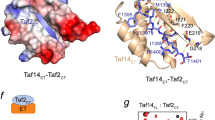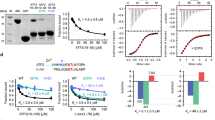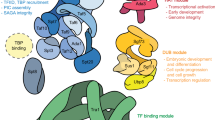Abstract
The ATF7 proteins, which are members of the cyclic AMP responsive binding protein (CREB)/activating transcription factor (ATF) family of transcription factors, display quite versatile properties: they can interact with the adenovirus E1a oncoprotein, mediating part of its transcriptional activity; they heterodimerize with the Jun, Fos or related transcription factors, likely modulating their DNA-binding specificity; they also recruit to the promoter a stress-induced protein kinase (JNK2). In the present study, we investigate the functional relationships of ATF7 with hsTAF12 (formerly hsTAFII20/15), which has originally been identified as a component of the general transcription factor TFIID. We show that overexpression of hsTAF12 potentiates ATF7-induced transcriptional activation through direct interaction with ATF7, suggesting that TAF12 is a functional partner of ATF7. In support of this conclusion, chromatin immunoprecipitation experiments confirm the interaction of ATF7 with TAF12 on an ATF7-responsive promoter, in the absence of any artificial overexpression of both proteins. We also show that the TAF12-dependent transcriptional activation is competitively inhibited by TAF4. Although both TAF12 isoforms (TAF12-1 and -2, formerly TAFII20 and TAFII15) interact with the ATF7 activation region through their histone-fold domain, only the largest, hsTAF12-1, mediates transcriptional activation through its N-terminal region.
This is a preview of subscription content, access via your institution
Access options
Subscribe to this journal
Receive 50 print issues and online access
$259.00 per year
only $5.18 per issue
Buy this article
- Purchase on Springer Link
- Instant access to full article PDF
Prices may be subject to local taxes which are calculated during checkout







Similar content being viewed by others
Abbreviations
- ATF:
-
activating transcription factor
- TBP:
-
TATA-binding protein
- TAF:
-
TBP-associated factor
- HFD:
-
histone fold domain
- TFIID:
-
transcription factor IID
- IP:
-
immunoprecipitation
- MAP kinase:
-
mitogen-activated protein kinase
- JNK:
-
Jun N-terminal kinase
- CREB:
-
cyclic AMP responsive binding protein
- b-LZ:
-
basic region leucine zipper
- CRE:
-
cyclic AMP responsive binding
- SAGA:
-
SPT-ADA-GCN5-acetyltransferase
- STAGA:
-
SPT3-TAF9-GCN5-L acetyltransferase
- PCAF:
-
p300/CREB-binding protein-associated factor
- TFTC:
-
TBP-free TAF-containing complex
- CMV:
-
cytomegalovirus
- TK:
-
thymidine kinase
- GST:
-
glutathione S-transferase
- HA:
-
hemaglutinin
- WB:
-
Western blot
- ChIP:
-
chromatin-immunoprecipitation
References
Acker J, de Graaff M, Cheynel I, Khazak V, Kedinger C and Vigneron M . (1997). J. Biol. Chem., 272, 16815–16821.
Albright SR and Tjian R . (2000). Gene, 242, 1–13.
Bell B and Tora L . (1999). Exp. Cell Res., 246, 11–19.
Bhaumik SR and Green MR . (2002). Mol. Cell. Biol., 22, 7365–7371.
Bocco JL, Bahr A, Goetz J, Hauss C, Kallunki T, Kedinger C and Chatton B . (1996). Oncogene, 12, 1971–1980.
Brand M, Leurent C, Mallouh V, Tora L and Schultz P . (1999). Science, 286, 2151–2153.
Chang CI, Xu BE, Akella R, Cobb MH and Goldsmith EJ . (2002). Mol. Cell, 9, 1241–1249.
Chatton B, Bahr A, Acker J and Kedinger C . (1995). Biotechniques, 18, 142–145.
Chatton B, Bocco JL, Gaire M, Hauss C, Reimund B, Goetz J and Kedinger C . (1993). Mol. Cell. Biol., 13, 561–570.
Chatton B, Bocco JL, Goetz J, Gaire M, Lutz Y and Kedinger C . (1994). Oncogene, 9, 375–385.
Cline J, Braman JC and Hogrefe HH . (1996). Nucleic Acids Res., 24, 3546–3551.
Dedon PC, Soults JA, Allis CD and Gorovsky MA . (1991). Anal. Biochem., 197, 83–90.
De Graeve F, Bahr A, Sabapathy KT, Hauss C, Wagner EF, Kedinger C and Chatton B . (1999). Oncogene, 18, 3491–3500.
de Wet JR, Wood KV, DeLuca M, Helinski DR and Subramani S . (1987). Mol. Cell. Biol., 7, 725–737.
Derijard B, Hibi M, Wu IH, Barrett T, Su B, Deng T, Karin M and Davis RJ . (1994). Cell, 76, 1025–1037.
Dikstein R, Zhou S and Tjian R . (1996). Cell, 87, 137–146.
Freiman RN, Albright SR, Zheng S, Sha WC, Hammer RE and Tjian R . (2001). Science, 293, 2084–2087.
Gaire M, Chatton B and Kedinger C . (1990). Nucleic Acids Res., 18, 3467–3473.
Gangloff Y, Romier C, Thuault S, Werten S and Davidson I . (2001). Trends Biochem. Sci., 26, 250–257.
Gangloff YG, Werten S, Romier C, Carre L, Poch O, Moras D and Davidson I . (2000). Mol. Cell. Biol., 20, 340–351.
Goetz J, Chatton B, Mattei MG and Kedinger C . (1996). J. Biol. Chem., 271, 29589–29598.
Ho DT, Bardwell AJ, Abdollahi M and Bardwell L . (2003). J. Biol. Chem., 278, 32662–32672.
Hoffmann A, Chiang CM, Oelgeschlager T, Xie X, Burley SK, Nakatani Y and Roeder RG . (1996). Nature, 380, 356–359.
Hoffmann A, Oelgeschlager T and Roeder RG . (1997). Proc. Natl. Acad. Sci. USA, 94, 8928–8935.
Hoffmann A and Roeder RG . (1996). J. Biol. Chem., 271, 18194–18202.
Ivashkiv LB, Liou HC, Kara CJ, Lamph WW, Verma IM and Glimcher LH . (1990). Mol. Cell. Biol., 10, 1609–1621.
Jacq X, Brou C, Lutz Y, Davidson I, Chambon P and Tora L . (1994). Cell, 79, 107–117.
Kaszubska W, van Huijsduijnen RH, Ghersa P, De Raemy-Schenk AM, Chen BP, Hai T, De Lamarter JF and Whelan J . (1993). Mol. Cell. Biol., 13, 7180–7190.
Kumar V and Chambon P . (1988). Cell, 55, 145–156.
Lavigne AC, Gangloff YG, Carre L, Mengus G, Birck C, Poch O, Romier C, Moras D and Davidson I . (1999). Mol. Cell. Biol., 19, 5050–5060.
Leurent C, Sanders S, Ruhlmann C, Mallouh V, Weil PA, Kirschner DB, Tora L and Schultz P . (2002). EMBO J., 21, 3424–3433.
Leurent C, Sanders SL, Demeny MA, Garbett KA, Ruhlmann C, Weil PA, Tora L and Schultz P . (2004). EMBO J., 23, 719–727.
Liu F and Green MR . (1990). Nature, 345, 361–364.
Livingstone C, Patel G and Jones N . (1995). EMBO J., 14, 1785–1797.
Maekawa T, Sakura H, Kanei-Ishii C, Sudo T, Yoshimura T, Fujisawa J, Yoshida M and Ishii S . (1989). EMBO J., 8, 2023–2028.
Martinez E . (2002). Plant Mol. Biol., 50, 925–947.
Martinez E, Palhan VB, Tjernberg A, Lymar ES, Gamper AM, Kundu TK, Chait BT and Roeder RG . (2001). Mol. Cell. Biol., 21, 6782–6795.
Mazzarelli JM, Mengus G, Davidson I and Ricciardi RP . (1997). J. Virol., 71, 7978–7983.
Mencia M, Moqtaderi Z, Geisberg JV, Kuras L and Struhl K . (2002). Mol. Cell, 9, 823–833.
Mengus G, Gangloff YG, Carre L, Lavigne AC and Davidson I . (2000). J. Biol. Chem., 275, 10064–10071.
Mengus G, May M, Carre L, Chambon P and Davidson I . (1997). Genes Dev., 11, 1381–1395.
Mengus G, May M, Jacq X, Staub A, Tora L, Chambon P and Davidson I . (1995). EMBO J., 14, 1520–1531.
Munz C, Psichari E, Mandilis D, Lavigne AC, Spiliotaki M, Oehler T, Davidson I, Tora L, Angel P and Pintzas A . (2003). J. Biol. Chem., 278, 21510–21516.
Perletti L, Dantonel JC and Davidson I . (1999). J. Biol. Chem., 274, 15301–15304.
Pham AD, Muller S and Sauer F . (1999). Mech. Dev., 84, 3–16.
Pollard H, Remy JS, Loussouarn G, Demolombe S, Behr JP and Escande D . (1998). J. Biol. Chem., 273, 7507–7511.
Purrello M, Di Pietro C, Viola A, Rapisarda A, Stevens S, Guermah M, Tao Y, Bonaiuto C, Arcidiacono A, Messina A, Sichel G, Grzeschik KH and Roeder R . (1998). Oncogene, 16, 1633–1638.
Shen WC, Bhaumik SR, Causton HC, Simon I, Zhu X, Jennings EG, Wang TH, Young RA and Green MR . (2003). EMBO J., 22, 3395–3402.
Steghens JP, Min KL and Bernengo JC . (1998). Biochem. J., 336 (Part 1), 109–113.
Timmers HT and Tora L . (2005). Trends Biochem. Sci., 30, 7–10.
Tora L . (2002). Genes Dev., 16, 673–675.
van Dam H, Wilhelm D, Herr I, Steffen A, Herrlich P and Angel P . (1995). EMBO J., 14, 1798–1811.
Walker AK, Rothman JH, Shi Y and Blackwell TK . (2001). EMBO J., 20, 5269–5279.
Wang EH, Zou S and Tjian R . (1997). Gene Dev., 11, 2658–2669.
Werten S, Mitschler A, Romier C, Gangloff YG, Thuault S, Davidson I and Moras D . (2002). J. Biol. Chem., 277, 45502–45509.
Whelan J, Ghersa P, Hooft van Huijsduijnen R, Gray J, Chandra G, Talabot F and DeLamarter JF . (1991). Nucleic Acids Res., 19, 2645–2653.
Xiao JH, Davidson I, Matthes H, Garnier JM and Chambon P . (1991). Cell, 65, 551–568.
Xie X, Kokubo T, Cohen SL, Mirza UA, Hoffmann A, Chait BT, Roeder RG, Nakatani Y and Burley SK . (1996). Nature, 380, 316–322.
Acknowledgements
We thank L Tora, YG Gangloff, G Mengus, T Oegelschläger and M Vigneron for gifts and helpful discussions. This work was supported by funds and/or fellowships from the Centre National de la Recherche Scientifique, the Institut National de la Recherche Médicale, the Université Louis Pasteur de Strasbourg, the French Ministry of Research, the Association pour la Recherche sur le Cancer (contracts 5701 and 4521) and the Ligue Nationale contre le Cancer – Comités Alsace et Vosges.
Author information
Authors and Affiliations
Corresponding author
Rights and permissions
About this article
Cite this article
Hamard, PJ., Dalbies-Tran, R., Hauss, C. et al. A functional interaction between ATF7 and TAF12 that is modulated by TAF4. Oncogene 24, 3472–3483 (2005). https://doi.org/10.1038/sj.onc.1208565
Received:
Revised:
Accepted:
Published:
Issue Date:
DOI: https://doi.org/10.1038/sj.onc.1208565



